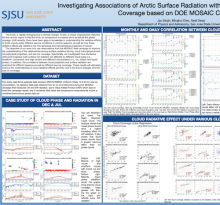Arctic Cloud Microphysical and Macrophysical Properties and Radiative Effects Using the MOSAIC Field Campaign
Jay
Singh
San Jose State University
Poster
The Arctic is rapidly changing due to climate change. In fact, a unique characteristic reported for that remote region is that the Arctic air temperature increases twice as fast as the global average. Until recently, there have been gaps in knowledge in understanding the radiative effects of Arctic clouds under different sea ice conditions in various seasons, as well as how these radiative effects are related to the microphysical and macrophysical properties of clouds. In 2019, the Multidisciplinary Drifting Observatory For The Study of Arctic Climate (MOSAIC) campaign funded by DOE ARM program was launched to better understand the surface energy budget of sea ice, clouds and precipitation, aerosols and atmospheric boundary layer.
The objective of our work is to use observations from the MOSAIC field campaign to improve the understanding of the relationships among surface radiative forcing, cloud macrophysical and microphysical properties, and sea ice coverage. Specifically, we investigated how shortwave (SW) and longwave (LW) surface net radiation are affected by different cloud types (i.e., stratiform, convective, and high clouds) and different cloud phases (i.e., ice, mixed, and liquid phase). In addition, the correlations between cloud properties and surface radiation are examined for different seasons as well as different sea ice coverage. These results will ultimately improve the understanding of cloud radiative effects and their role in the future changes of Arctic sea ice coverage.
The objective of our work is to use observations from the MOSAIC field campaign to improve the understanding of the relationships among surface radiative forcing, cloud macrophysical and microphysical properties, and sea ice coverage. Specifically, we investigated how shortwave (SW) and longwave (LW) surface net radiation are affected by different cloud types (i.e., stratiform, convective, and high clouds) and different cloud phases (i.e., ice, mixed, and liquid phase). In addition, the correlations between cloud properties and surface radiation are examined for different seasons as well as different sea ice coverage. These results will ultimately improve the understanding of cloud radiative effects and their role in the future changes of Arctic sea ice coverage.

singh-jay-polar-poster.pdf
(3.77 MB)
